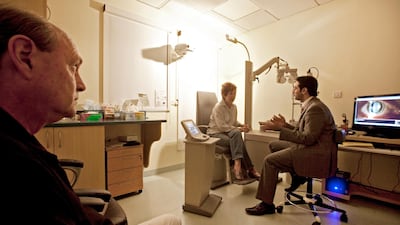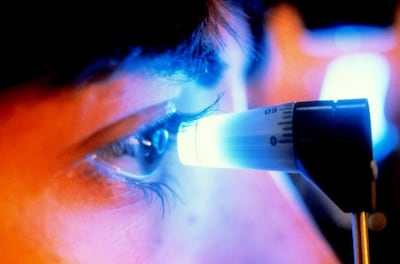Spending hours looking at screens could be contributing to high levels of dry eye disease in the UAE, according to a study.
Research involving hundreds of Dubai residents found that almost two thirds had the condition, a much higher figure than the global average.
People who spent many hours looking at screens each day were at higher risk of the condition, while researchers also suggested that air conditioning and the climate could be contributing to the condition.
"A high amount of screen time is associated with dry eyes due to the decrease in the blink rate in screen users, which disturbs the tear film," the researchers wrote in their paper in the journal BMC Ophthalmology.
In the study, 452 participants were quizzed on the state of their eyes using the Ocular Surface Disease Index (OSDI), a well-established questionnaire.
Participants were students and staff at the Mohammed bin Rashid University of Medicine and Health Sciences, or who worked at Mediclinic's City and Parkview hospitals in Dubai.
The overall prevalence of dry eye disease – meaning an OSDI score of 13 or more – was 62.6 per cent.
That is about three times as high as a widely quoted average of one in five people having the condition.
Compared with countries with much lower rates, the researchers said a couple of issues could be at play.
“This variation may be influenced by factors that could include climate and lifestyle differences between the locations,” they wrote.
The prevalence was 66 per cent among people who had more than six hours of screen time a day, while for those who had three to six hours each day the figure was 61 per cent.
Prevalence was lowest, at 50 per cent, among respondents who spent less than three hours a day looking at screens.
Dry eye disease can result in discomfort such as stinging or burning, and sometimes causes damage to parts of the eye surface, the tear glands and the eyelid.
Why dry eye disease must be properly diagnosed
The Mayo Clinic in the US says that dry eye disease develops when tears do not provide adequate lubrication for the eyes.
While often easily treated, it may be the result of an underlying condition, including autoimmune diseases, which involve problems with the body’s immune system.
The researchers said it was important for the condition to be diagnosed early so that patients did not develop complications.
“This widespread prevalence emphasises the role of the general practitioner to refer patients to ophthalmologists, especially if they have autoimmune diseases or are taking long-term medications,” the scientists wrote.
“Public health officials should aim to educate the population that dry eyes may be an indicator of other chronic diseases.”
The paper, The prevalence, severity, and risk factors for dry eye disease in Dubai – a cross sectional study, found that people who wore contact lenses were more likely to develop the condition.
Women were more at risk than men, while prevalence was slightly lower among older respondents, a result that contrasts with other studies.
The researchers speculated that the group they surveyed may spend more time than average looking at screens, which may help to explain the high prevalence, although they reported that other studies in the Gulf have also indicated the condition is common.
They also suggested that the participants may have a lot of exposure to air conditioning, which could contribute to high rates of dry eye disease “because low humidity is a risk factor for dry eyes”.
Previous investigations found a prevalence of 65.4 per cent in eastern Saudi Arabia, while other research reported in the study found both much higher and much lower figures in the country.
Scientists have previously found a prevalence of 59 per cent in Jordan, a stark contrast to China, at 17 per cent, and Spain, at 11 per cent.







